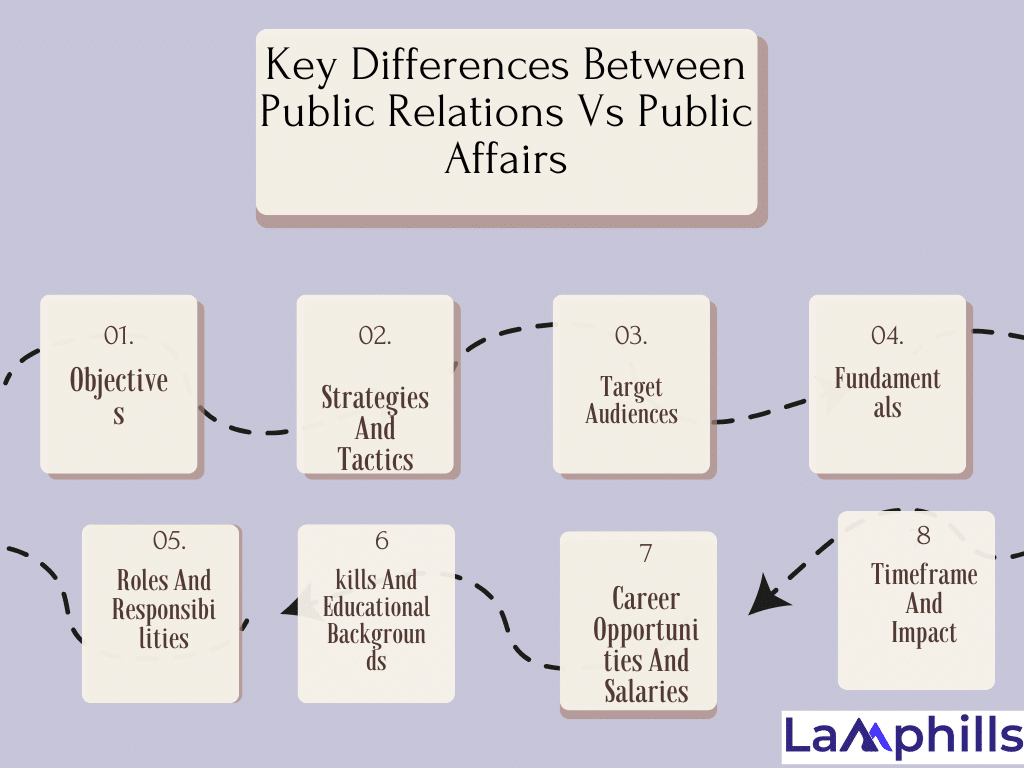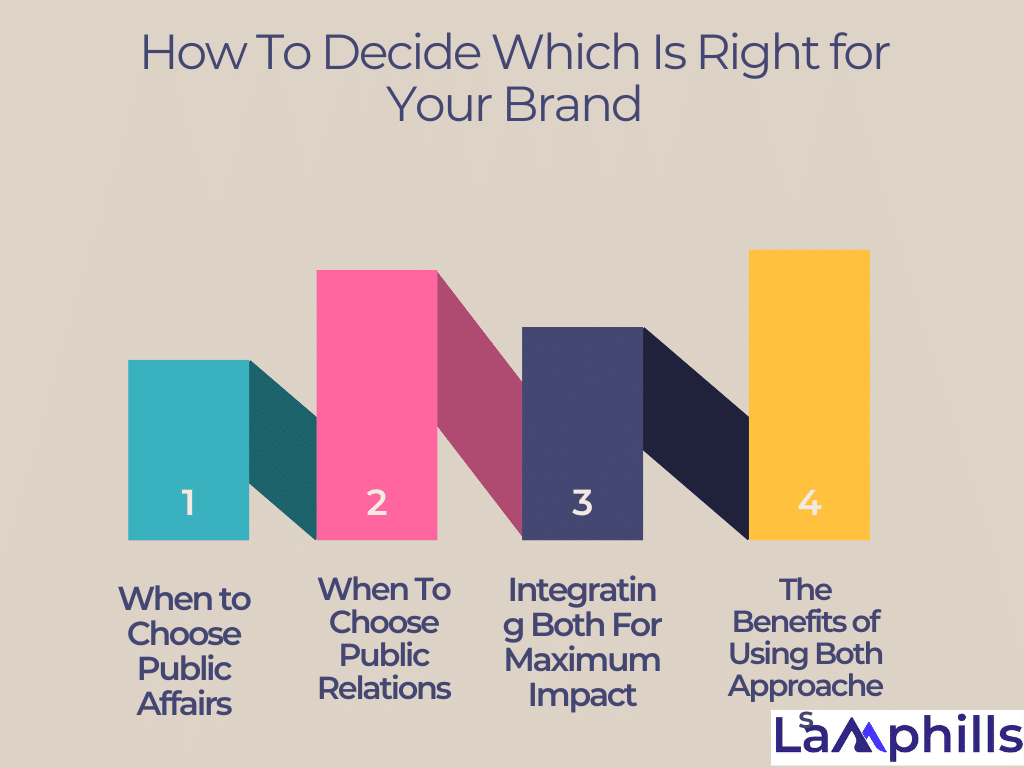Having worked with organizations on their communication strategies, I saw a recurring thread: many companies failed to distinguish between public affairs and public relations. Some people even used the terms interchangeably, assuming they were the same. It’s a simple error to make, given that both entail developing relationships and molding perceptions. However, as I’ve learned from years of experience in the sector, the differences between the two can make all the difference in determining the best approach for your company. In this article, I’ll explain the distinctions and help you decide whether public affairs vs. public relations is a better fit for your brand’s goals.
Key Takeaways
- Public relations (PR) aims to build and manage a brand’s reputation through media and public engagement, focusing on marketing goals like improving brand image and handling crises. Public affairs, however, is centered around influencing public policy, engaging with government officials, and building relationships that can impact laws and regulations.
- PR professionals use media outreach, social media, and storytelling to generate positive publicity and enhance brand visibility. Public affairs specialists rely more on lobbying, stakeholder engagement, and advocacy to shape public policy and influence decision-making among lawmakers.
- Public relations targets the general public and media outlets to create demand and visibility for brands, while public affairs focuses on policymakers, legislators, and stakeholders who play a direct role in shaping regulations and laws that impact businesses.
- Public affairs tend to have a long-term focus, often taking months or years to build relationships that can affect policy changes. PR, in contrast, can achieve more immediate results, such as quickly shifting public perception through a well-timed press release or campaign.
- Public affairs is best suited for businesses needing to navigate regulatory environments, especially in industries like energy or pharmaceuticals where policy changes can greatly impact operations. PR is ideal for brands looking to shape their image, tell their story, and build trust with the public through ongoing media and public engagement.
Definition Of Public Relations
Public relations (PR) is more outward-looking, dealing directly with the public and media. If public affairs is about working quietly behind the scenes, public relations is like hosting a big stage performance. It is about managing how the world perceives your brand and telling the proper tales. Think about press releases, interviews, social media campaigns, and public image management for your brand.
The primary goal of public relations is to help improve a company’s or individual’s image through marketing. However, rather than running paid commercials, public relations specialists aim to generate favorable exposure. For example, if a corporation wants to appeal to youthful consumers, public relations professionals may build a whimsical internet presence using social media or create a funny or cute mascot. This can help encourage interest in the company, which may lead to word-of-mouth advertising. In addition to establishing online campaigns, these specialists may develop public relations initiatives to increase brand exposure, such as writing a news release, cooperating with an influencer, and attending industry or community events.
Essentially, the PR team you engage will evaluate your organization, identify any relevant messages or contributions, and turn them into a positive marketing story. They’ll use social media, press, and word-of-mouth to try to create excitement about your brand.
And if things unexpectedly go south for your firm, a public relations agency will prepare a reaction and find a way to portray it in the best possible light. Here are some of the ways they might do this:
- Drafting press releases.
- Public relations crisis management.
- Send pitches to journalists.
- Reaching out to media outlets.
- Branding.
- Social media.
- Blogging and writing.
- Launching PR campaigns.
- Writing speeches.
Definition Of Public Affairs
Here’s a template to help you craft a successful public affairs strategy, with key components to consider along the way.
Many people are unaware of the amount of labor that goes on behind the scenes in public affairs. It is all about working with legislators, government agencies, and community leaders to change regulations, laws, and public policies that may affect your business. Consider this: you’re acting as an advocate, not just for your business but also for your whole industry.
Public affairs professionals collaborate with businesses and individuals, but their primary concentration is on public policy and lawmaking. New laws enacted by federal and state legislatures have an impact on commercial interests.
Public affairs can also entail assisting firms in developing positive relationships with their stakeholders. Stakeholders are an important component of any organization, thus it’s in a company’s best interest to maintain a solid relationship with them.
Companies often use public affairs as a way to bridge the gap between business interests and public policy. Here are some of the ways public affairs does this:
- Regularly establishing contact with politicians, political advisors and government regulators.
- Maintaining a strong relationship with company stakeholders.
- Monitoring policy proceedings.
- Contacting journalists.
- Building relationships with media outlets.
- Leveraging the power of words to influence public policy.
Understanding Public Affairs vs. Public Relations

Public affairs vs public relations, as the names imply, both need interaction with the general public. It encompasses issues that directly influence the public, such as legislation or public administration. Public relations helps to bridge the gap between the general public and organizations. As a result, public affairs responsibilities are often linked with non-corporate institutions, such as government agencies or nonprofits, while public relations is commonly associated with the commercial sector.
These alignments often influence the exact positions that ambitious public relations or public affairs professionals seek. For example, the business nature of public relations attracts people to corporate careers such as communications assistant, social media strategist, or marketing specialist. Individuals interested in public affairs, on the other hand, could pursue jobs more in tune with government or nonprofit entities, such as lobbyists, government relations monitors, or community affairs managers.
Professionals in public affairs and public relations aim to establish solid public relationships built on a foundation of trust. Without trust, the information shared might be ignored or not wholly considered. For businesses, this can affect their bottom line. For a government agency or nonprofit, it can harm its effectiveness in accomplishing policy goals.
Key Differences Between Public Relations Vs Public Affairs

Now that we’ve covered the essentials, let’s look at what distinguishes public affairs from public relations. Knowing the distinctions will help you make a more informed decision about which strategy is better for your brand.
#1. Objectives : Public Affairs vs. Public Relations
The basic goal of public relations is to improve an organization’s reputation by boosting awareness, generating interest, establishing authority, and fostering consumer loyalty. Campaigns with a specific public relations goal typically try to increase traffic, improve company image, and manage crises.
Public affairs, on the other hand, is more politically oriented, to influence policy and decision-making through interactions with elected officials and parliamentarians. Public affairs campaigns may include:
- Advocating for policy changes
- Legislative support
- Enhancing community relations
- Strengthening relationships with stakeholders and influencers.
#2. Strategies And Tactics
Public relations uses media outreach and social media management as major tactics for promoting a positive public image and engaging with target audiences. Connecting with journalists, editors, bloggers, and social media influencers is part of media outreach, which aims to boost public visibility and spread an organization’s message. In contrast, public affairs uses lobbying and stakeholder engagement to shape public opinion and policy. This involves:
- Mapping stakeholders
- Analyzing stakeholders
- Prioritizing stakeholders
- Engaging stakeholders
- Monitoring stakeholders
- Reviewing stakeholders
These activities are done to ensure effective communication and address the concerns and interests of stakeholders.
#3. Target Audiences
Public relations is aimed at the general public and media outlets, who are significant stakeholders with a common interest in or concern about a company. By focusing on the broader public, public relations specialists can enhance demand for a product, service, or idea while also raising the organization’s profile.
In contrast, public affairs is oriented toward policymakers, lawmakers, and stakeholders, who have a direct impact on the development and execution of public policies and legislation. Public affairs professionals aim to:
- Develop support for their organization’s agenda by disseminating information to stakeholders
- Influence public policy
- Establish and maintain strong relationships with elected officials and the public.
#4. Fundamentals
Public relations vs public affairs are two distinct disciplines with different purposes, although both aim to achieve certain organizational objectives. These specialists constructs a well-known brand for a firm and use marketing methods such as developing partnerships with media to highlight the organization’s skills and to establish, sustain, and expand the organization’s good image.
Public affairs professionals are more focused on influencing legislators, politics, and public policy. These professionals develop relationships with citizens, elected officials, agency executives, and their staff in order to advocate for policies that will benefit the organization’s success.
#5. Roles And Responsibilities
With a clearer understanding of the differences between public relations and public affairs, let’s explore the distinct roles and responsibilities that professionals in each field undertake.
- PR professionals are responsible for:
- Constructing and managing the brand image and spokespersons’ reputation
- Managing crises
- Devising and executing PR strategies and campaigns
- Producing and circulating press releases, speeches, and promotional materials
- Forming and upholding ties with the media
- Answering media inquiries and requests for information
- Evaluating and creating PR strategies that align with the organization’s objectives
- Working with the marketing department to ensure PR campaigns are in line with overall marketing strategies.
In addition to their core responsibilities, PR professionals need to be adept at storytelling to enhance brand reputation, capture the attention of their target audience, and build lasting connections with media outlets.
- Public Affairs Professionals
Public affairs professionals focus on communicating with government officials and media, fostering and developing the image of a brand or organization, constructing public affairs strategies, amalgamating government relations and media communications, and generating informative materials. This often involves advocating for policies, collaborating with legislators, and assessing the effects of political decisions on organizations.
Public affairs professionals must possess the following skills and knowledge to succeed in their roles:
- Knowledge of politics and policy-making
- Familiarity with the legislative process
- The capacity to effectively communicate with government representatives
#6. Skills And Educational Backgrounds
Having delved into the unique roles and responsibilities of public relations and public affairs professionals, comprehending the specific skills and educational backgrounds needed for success in each field becomes vital.
- Common Skills
Both public relations and public affairs professionals need strong communication, research, and analytical skills to excel in their respective fields. These skills enable them to evaluate the efficacy of their strategies, analyze intricate and contentious topics, and make informed choices, while effectively communicating with various stakeholders and conducting research to inform their strategies.
- Unique Skills and Expertise
PR professionals require expertise in:
Media Relations
- Crisis management
- Crafting creative narratives about an organization and its personnel
- Capturing the attention of their target audience
- Building lasting connections with media outlets
- Employing storytelling to enhance brand reputation
Public affairs specialists, on the other hand, need knowledge of politics and policy-making, as well as a solid understanding of the legislative process, to effectively communicate with government representatives and advocate for their clients’ interests.
Educational Requirements
PR specialists often have degrees in PR, journalism, or marketing, which provide them with essential skills such as:
- research
- verbal communication
- writing
- strategic communication
In addition, some professionals pursue certifications from reputable organizations such as the Public Relations Society of America or the International Association of Business Communicators.
Public affairs specialists typically study political science, business, or economics, equipping them with the skills and qualifications needed to pursue a career in public affairs. A master’s degree in the field of political science can further enhance career prospects in public affairs.
#7. Career Opportunities And Salaries
Career possibilities and pay differ between public relations and public affairs, with PR specialists often earning more than public affairs professionals, with average salaries of $65,060 and $59,534, respectively. However, depending on one’s interests and expertise, both areas provide a variety of fulfilling job opportunities.
They frequently work in office environments within an organization’s marketing or public relations divisions or at a public relations firm, although they may also work with agencies, enterprises, or individuals.
#8. Timeframe And Impact
Public affairs frequently require a longer time horizon—it can take months or even years to establish the kinds of relationships that impact policy. In contrast, public relations can produce more immediate results. A properly timed press release can influence the conversation around your brand overnight.
How To Decide Which Is Right for Your Brand

Choosing between public affairs and public relations isn’t always straightforward. Each serves a different purpose and can be more effective in specific situations. Let’s dive into when you might choose each approach.
A. When to Choose Public Affairs
Public affairs shines in situations where your business needs to navigate the complexities of regulations, engage with local communities, or influence public policy. This strategy is like a chess game—you need to think several steps ahead, building relationships with key players and understanding how changes in laws or regulations might impact your business.
Public affairs is ideal for circumstances like this when you need to traverse complex regulatory frameworks or obtain support from local stakeholders. It is not about obtaining plenty of media attention; it is about making sure the correct people understand and support your cause.
Some industries are inherently more reliant on public relations methods. Consider industries such as medicines, energy, technology, or telecommunications, where a change in the law or regulation can make or ruin a company. I once worked for a tech business building a product based on forthcoming 5G technologies. But before they could proceed, they needed to collaborate with government agencies to guarantee that the technology met new safety rules. Public affairs became their main concern, as they needed to be at the table for discussions on policy that would impact their entire industry.
These types of businesses can’t afford to be passive; they have to be proactive in shaping the laws and regulations that affect their operations. And that’s exactly where public affairs steps in.
B. When To Choose Public Relations
Public relations, on the other hand, is all about shaping your brand’s image and building a strong relationship with the public. It’s perfect for brands that want to tell their story, build trust with their audience, and create a positive reputation.
When I worked with a startup that was launching a new health and wellness app, I witnessed the power of public relations firsthand. They were keen to build publicity and get people interested in their goods. Unlike the meticulous and long-term nature of public affairs, this circumstance necessitated something quick and attention-grabbing. We established a public relations campaign that included press releases, influencer collaborations, and a launch event that generated attention in the local media.
What is the result? Within weeks, their app was highlighted on multiple tech blogs and local news outlets, resulting in thousands of downloads in just the first month alone. The speed and reach of PR made it the ideal tactic for getting their word out there masses quickly.
PR is most effective when you want to make a big splash—whether you’re launching a new product, dealing with a crisis, or simply trying to establish a greater brand presence in your market. It’s about crafting a story that connects with your audience and shapes how they see your brand.
C. Integrating Both For Maximum Impact
In an ideal world, businesses wouldn’t have to choose between public affairs and PR—they’d use both for a comprehensive strategy. And the truth is, many successful brands do exactly that. They understand that while public affairs helps to build strong relationships with policymakers and stakeholders, PR helps tell their story to a broader audience.
D. The Benefits of Using Both Approaches
Let’s return to the renewable energy company scenario I described before. They didn’t stop there after securing local government consent through their public affairs activities. They shifted gears and used public relations to promote the wind farm’s groundbreaking, highlighting how it would help the neighborhood by providing clean energy and job opportunities. Also, they invited local journalists, sent out press releases, and posted project videos on social media.
This dual approach enabled them to not only obtain the necessary permissions but also to build goodwill with the general public. The result was a successful rollout of their new initiative and a favorable public view, which helped them gain additional financing.
This type of plan succeeds because each technique complements the others. Public Affairs lays the groundwork by ensuring that regulatory and community concerns are addressed, while PR amplifies the message, making sure it reaches the people who matter most to the brand.
In summary, choosing between public affairs and public relations, or combining the two, is entirely dependent on your brand’s specific demands and goals. If you need to handle the complexities of government rules or get support from community groups, public affairs should be your priority. However, if you want to share your narrative, establish a strong public image, and reach a larger audience, PR is the way to go.
What does public affairs focus on?
Public affairs professionals work to influence public policy, build strong reputations with stakeholders and manage media communications and information dissemination. They aim to find common ground and ensure corporate and social responsibility.
What are some common strategies used in public relations?
Common public relations strategies include media outreach, social media management, and public outreach initiatives. These help to promote positive public relations and communicate effectively with stakeholders.
What are the three components of public affairs?
Public affairs involves ethical leadership, cultural competence, and community engagement, as well as communications, government relations, and public issue management.
Summary
Deciding between public affairs and public relations comes down to your brand’s unique needs and goals. If you’re looking to influence policy or engage with communities on a deeper level, public affairs is likely your best bet. But if your focus is on building a strong public image and reaching consumers, PR might be the way to go. And remember, you don’t have to choose just one—many successful brands leverage both to create a well-rounded strategy.
Also, understanding the distinctions between public relations vs public affairs is crucial for navigating the complex world of shaping public opinion and influencing decision-making processes. While both fields share some similarities, their objectives, strategies, and target audiences differ significantly. By gaining a deeper understanding of these differences, one can better appreciate the unique contributions of public relations and public affairs professionals in their respective fields and explore the diverse career opportunities and educational paths available in each domain.




